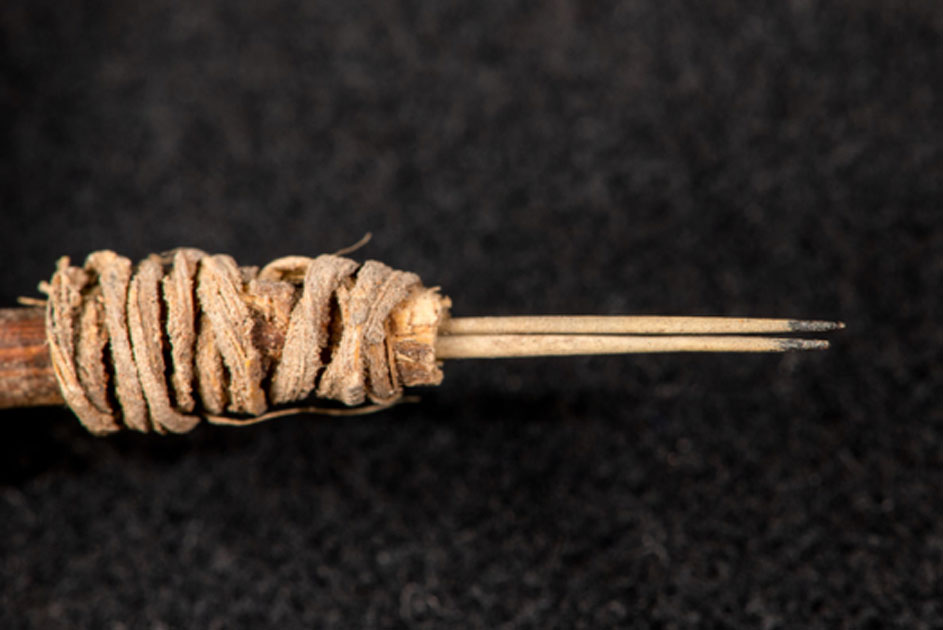Ancient Tattoo Tool Rewrites the History of Native American Ink
A Ph.D. student has made an astonishing discovery - the earliest known Native American tattoo artifact. It is estimated that it is 2000-years-old and came from the very important Basket-maker II culture. The find is helping experts to understand the story of this hitherto enigmatic culture that was very influential in the development of the Pueblo civilization in the South-West United States.
Andrew Gillreath-Brown, an anthropology Ph.D. candidate, was cataloging artifacts that were recovered from an archaeological site in the south of Utah. These items had been unearthed in 1972 and deposited in Washington State University but not properly examined. According to Heritage Daily, the researcher discovered a “3 ½ inch wooden skunkbush sumac handle bound at the end with split yucca leaves and holding two parallel cactus spines, stained black at their tips.” A chemical analysis of the pigment on the tips of the cactus spines found a residue of carbon which is often used in ancient tattooing ink.

Close up of the 2,000-year-old cactus spine tattoo tool’s inky points. (Bob Hubner/WSU)
The artifact is about the size of a pen and Gillreath-Brown tested the tattooing instrument’s efficiency by reconstructing one based on the materials. He used the replica to tattoo pieces of pig skin.
- Ancient Ink: How Tattoos Can Reveal Hidden Stories of Past Cultures
- Were Norsemen Tattooed? Evidence of Ink on the Rugged Rusiyyah
- Oldest Known Evidence of Tobacco Use in North America Found in Ice Age Hunting Camp

Replica of the Native American tattooing instrument. (Robert Hubner, Washington State University)
Native American Tattoos and Body Art
There have been relatively few artifacts for body painting found in America. This is despite the fact that written records and rock art would indicate that body art was very common among the Pre-Columbian population. The study of permanent body painting was hampered because there are no preserved mummies in the American West, unlike in other parts of the globe.
The find is important because they are the “oldest tattoo artifacts in western North America” according to KEPR.tv.com. They are some 1000 years older than anything previously found in the region. The researcher was able to date the implement because of the other items found with it 40 years ago. His find is revolutionizing the history of body art in America before the coming of the Europeans.

Selected Basketmaker III unfired clay figurines exhibiting punctate designs that may represent body decoration. (A) Segi Canyon, AZ. (B, C) Prayer Rock District, AZ. (D) Canyon de Chelly, AZ. (Gillreath‑Brown et al.)
Tattoos in Other Ancient Societies
It is now generally accepted that tattoos and tattooing can help us to understand ancient societies. According to the researcher’s paper in the Journal of Archaeological Science, body art is important for insights into “cultural expressions of achievement, group allegiances, identity, and status.” Tattoos were not just fashion statements but were culturally, religiously, and socially significant.
The find of the oldest tattoo artifact is very important as it is helping the researcher to understand the so-called Neolithic Demographic. This when the population increased as they adopted agriculture in the American South-West. There is only a limited archaeological record for the development of early Native American cultures and groups at this critical time.
- 10,000 Years of Landscape Architecture by the Ancient Cultures of Utah
- Hundreds of ancient children’s shoes found in Utah cave shed light on little-known culture
- Power, Perils and Rites of Passage – The History of the Female Tattoo

The artifact is about the size of a pen. (Washington State University)
Ancestral Pueblo People
The instrument has been linked to the Basket-maker II culture that flourished in New Mexico, Utah, and Arizona between 1000 BC to approximately 100 AD. This was a nomadic culture that gradually adopted the cultivation of maize and over time became sedentary. They were expert basket weavers and lived in pit-houses or caves. It is widely believed that their descendants are the Pueblo peoples. These are Native Americans who build towns made of adobe brick and were farmers before the arrival of Europeans. The Pueblo people share a common language and culture and are still numerous in states such as Arizona and New Mexico.
The find indicates that at least by the 1st century AD the Basket-maker II culture was using body art. This would indicate that they had become more socially stratified and this means that they had developed a sophisticated society and their nomadic hunter lifestyle had evolved to some degree. The find may also help us to understand the relationships between people and classes in that culture.
Top image: A 2,000‑year‑old cactus spine Native American tattoo tool discovered by WSU archaeologist Andrew Gillreath‑Brown. Source: Washington State University
By Ed Whelan




















Comments
Although their architectural styles and many of their tribal customs and religious practices were similar, the Pueblo peoples did NOT share a common language. By some accounts, there were at least 6 languages utilized by the various pueblos in present-day New Mexico